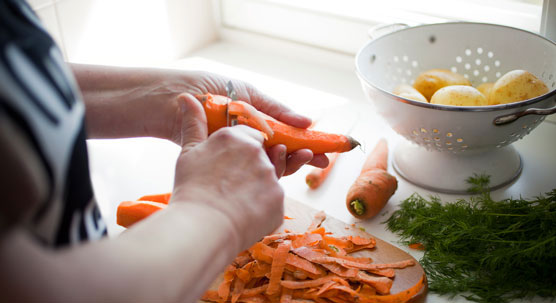Press release 2017-02-03 at 8:48

The easiest way to reduce nutrient pollution is to eat more domestic wild fish and vegetables.
A joint press release of the Finnish Environment Institute, Natural Resources Institute Finland and John Nurminen Foundation
With the calculator developed by the Finnish Environment Institute and the Natural Resources Institute Finland, consumers can determine the impacts of their consumption habits on nutrient pollution in the Baltic Sea. Finland’s contribution to the nutrient pollution of the Baltic Sea is about 10 per cent. Food production accounts for about 60 per cent of the Baltic Sea footprint of an average Finnish consumer. Waste water is also an important source (about 25 per cent). The easiest way to reduce nutrient pollution is to eat more domestic wild fish and vegetables.
The Baltic Sea calculator is the first of its kind in the world. Even though the calculator has been prepared by top experts, the knowledge base must still be expanded.
“The calculator covers the most important sources of pollution arising from consumption. It provides a new perspective on how consumers can help to improve the state of the Baltic Sea,” says Jyri Seppälä from the Finnish Environment Institute, who has been in charge of the project.
Baltic Sea footprints produced by consumers can be very different, both in terms of their size and profile.
“For example, the Baltic Sea footprint of a resident of Helsinki who does not eat meat is 20 per cent smaller than the footprint of a Helsinki resident who has a mixed diet,” explains Merja Saarinen from the Natural Resources Institute Finland.
“At the same time, the Helsinki resident with a mixed diet can reduce his footprint by 75 per cent by halving his meat consumption and by filling the gap with wild fish caught from the Baltic Sea,” Saarinen continues.
Results partially depend on the effectiveness of wastewater treatment
The pollution caused by consumption also depends on where the consumer lives as there are substantial differences in the wastewater treatment results between municipalities. There are particularly wide gaps in nitrogen removal rates, from about three per cent to 90 per cent. For example, in Helsinki wastewater discharges account for less than 10 per cent of all pollution arising from consumption, a result of effective wastewater treatment.
Spending time at holiday homes, horse riding, harness racing, golf and boating are the leisure activities included in the calculator. Horse riding and harness racing in particular have a major impact on consumers’ Baltic Sea footprint, a result of the large area of cultivated land required for producing feed for a large animal and the fact that the pollution generated by the horses is caused by the need of a relatively small number of people.
More detailed information about the use of agricultural land
The material collected for the calculator was structured in a new manner, which provided the calculator team with more information on such matters as the use of agricultural land in Finland. At the moment about 70 per cent of all cultivated land in Finland is used for the production of animal-based food. A total of 54 per cent of all productive agricultural land is used for the production of dairy products and beef. Combined production of milk and beef, a common production line in Finnish farms, is environmentally more sustainable than specialised beef production.
The calculator is based on statistics, models and research findings. However, there is not yet enough background information available on all areas. For example, it is still impossible to fully determine how organic farming and pets contribute to nutrient pollution in the Baltic Sea.
“It should also be remembered that in addition to the nutrient pollution aspect discussed in the context of the calculator, there are also other environmental factors, such as climate, biodiversity, and the purity and safety of food that may be important to consumers,” Jyri Seppälä adds.
Several parties were involved
The Baltic Sea calculator was first suggested by the newspaper Helsingin Sanomat after which the John Nurminen Foundation also became interested in the idea. The calculator was produced by the Finnish Environment Institute (SYKE) and the Natural Resources Institute Finland (Luke). Funding for the project also came from the Ministry of Agriculture and Forestry, the Ministry of the Environment, the John Nurminen Foundation and Helsingin Sanomat.
Phosphorus and nitrogen, the nutrients responsible for most of the eutrophication in the Baltic Sea, are considered in the calculator and the most important factors contributing to the pollution and neutralising it are also included. Nutrient pollution is caused by food production, wastewaters from municipalities and scattered dwellings, wastewater generated at holiday homes, energy consumption, mobility and other consumption. Catching and consumption of wild fish are factors neutralising the impacts of nutrient pollution.
Nutrient pollution accelerates the eutrophication of the Baltic Sea. Eutrophication causes blue-green algae and other algae to grow more rapidly and results in oxygen deficit in the deep waters of the Baltic Sea. Reducing nutrient discharges into the sea is crucial to improving the state of the Baltic Sea.
Persuading people to change their consumption habits will help to reduce pollution but results can also be achieved through water protection measures in agriculture and more effective treatment of municipal wastewater. At the same time, fishing is an effective way of removing nutrients from the sea. There are also projects under way in Finland in which the aim is to make water protection more effective, reduce nutrient discharges from agriculture and to recycle nutrients more effectively.
The Baltic Sea calculator (in Finnish)
Graphs
Further information
Professor Jyri Seppälä, Finnish Environment Institute, tel. +358 295 251 629, firstname.lastname@ymparisto.fi
Researcher Merja Saarinen, Natural Resources Institute Finland, tel. +358 295 326 506, firstname.lastname@luke.fi
Director Marjukka Porvari, John Nurminen Foundation, tel. +358 41 549 1535, firstname.lastname@jnfoundation.fi